Decomposition Analysis of Carbon Emissions from Energy Consumption in Beijing-Tianjin-Hebei, China: A Weighted-Combination Model Based on Logarithmic Mean Divisia Index and Shapley Value
Abstract
:1. Introduction
2. Measurement of Carbon Emissions from Energy Consumption
3. Decomposition Analysis Model of Carbon Emissions from Energy Consumption
- (1)
- The LMDI and the Shapley method are used to decompose carbon emissions of energy consumption into six factors, so the annual effects of various factors can be obtained;
- (2)
- According to the decomposition results, the Kendall compatibility coefficient [34] is used to test the compatibility of the two methods, then the model can be constructed after the test, so as to ensure the validity of the model;
- (3)
- After the consistency test, the weights can be obtained based on the calculation results of the LMDI and the SV method, then the weighted-combination decomposition analysis model will be constructed to analyze the factors.
3.1. The LMDI Decomposition Method
3.2. The SV Method
3.3. The Weighted-Combination Decomposition Model
3.3.1. Compatibility Check of the Models
3.3.2. Weighted-Combination
4. Results and Discussion
4.1. Decomposition Results of Singe Model
4.2. Decomposition Results of Weighted-Combination Model
4.3. Analysis of Decomposition Results
4.3.1. Cumulative Effects Analysis
4.3.2. Analysis of Energy Consumption Structure Effects
4.3.3. Analysis of Energy Consumption Intensity Effects
4.3.4. Analysis of Industrial Structure Effects
4.3.5. Analysis of Economic Development Effects
4.3.6. Analysis of Economic Population Size
4.4. Suggestions
4.4.1. Readjusting the Industrial Structure and Promoting Industrial Upgrading
4.4.2. Strengthening Technological Progress, and Constantly Reducing the Intensity of Energy Consumption
4.4.3. Actively Optimizing the Energy Structure
4.4.4. Building a Long-Term Carbon-Emissions-Reduction Mechanism
5. Conclusions
Author Contributions
Funding
Acknowledgments
Conflicts of Interest
Appendix A
| Year | Beijing | Tianjin | Hebei | ||||||
|---|---|---|---|---|---|---|---|---|---|
| Primary Industry | Secondary Industry | Tertiary Industry | Primary Industry | Secondary Industry | Tertiary Industry | Primary Industry | Secondary Industry | Tertiary Industry | |
| 2000 | 35.64 | 877.30 | 318.28 | 21.99 | 666.49 | 340.01 | 61.56 | 3170.95 | 282.58 |
| 2001 | 39.14 | 1084.33 | 359.92 | 27.85 | 775.36 | 307.76 | 57.30 | 3648.82 | 288.06 |
| 2002 | 38.07 | 1111.11 | 424.41 | 31.22 | 857.96 | 289.15 | 40.70 | 4229.06 | 115.97 |
| 2003 | 36.60 | 1108.66 | 446.09 | 20.17 | 862.80 | 303.35 | 50.14 | 5090.66 | 302.57 |
| 2004 | 36.20 | 1066.81 | 570.60 | 22.53 | 1018.36 | 359.57 | 47.77 | 5797.21 | 381.59 |
| 2005 | 34.90 | 1081.79 | 649.93 | 26.39 | 1035.80 | 356.51 | 62.57 | 7749.96 | 580.81 |
| 2006 | 37.66 | 1086.82 | 742.60 | 26.17 | 1207.28 | 365.00 | 36.04 | 8720.37 | 577.53 |
| 2007 | 39.27 | 1096.32 | 800.89 | 27.30 | 1362.88 | 374.89 | 40.16 | 9209.85 | 592.15 |
| 2008 | 38.98 | 924.57 | 833.29 | 27.14 | 1556.28 | 352.72 | 64.17 | 9920.47 | 768.32 |
| 2009 | 36.22 | 906.34 | 858.91 | 29.02 | 1707.19 | 383.12 | 62.93 | 10,168.98 | 788.81 |
| 2010 | 34.84 | 1038.49 | 864.97 | 31.79 | 2163.04 | 420.21 | 88.74 | 12,073.90 | 884.05 |
| 2011 | 34.31 | 774.74 | 904.35 | 35.58 | 2465.70 | 434.40 | 174.02 | 13,149.00 | 897.56 |
| 2012 | 32.19 | 730.24 | 948.72 | 38.81 | 2692.86 | 458.41 | 246.93 | 13,362.15 | 905.95 |
| 2013 | 30.48 | 537.44 | 931.47 | 33.81 | 2872.01 | 381.44 | 215.74 | 15,490.85 | 882.74 |
| Year | Beijing | Tianjin | Hebei | Total |
|---|---|---|---|---|
| 2000 | 1231.22 | 1028.50 | 3515.09 | 5774.81 |
| 2001 | 1483.39 | 1110.97 | 3994.19 | 6588.55 |
| 2002 | 1573.58 | 1178.33 | 4385.73 | 7137.64 |
| 2003 | 1591.35 | 1186.32 | 5443.37 | 8221.04 |
| 2004 | 1673.60 | 1400.46 | 6226.56 | 9300.62 |
| 2005 | 1766.62 | 1418.70 | 8393.35 | 11,578.67 |
| 2006 | 1867.08 | 1598.46 | 9333.94 | 12,799.48 |
| 2007 | 1936.48 | 1765.07 | 9842.17 | 13,543.72 |
| 2008 | 1796.84 | 1936.13 | 10,752.96 | 14,485.93 |
| 2009 | 1801.47 | 2119.33 | 11,020.72 | 14,941.52 |
| 2010 | 1938.29 | 2615.05 | 13,046.69 | 17,600.03 |
| 2011 | 1713.40 | 2935.67 | 14,220.58 | 18,869.65 |
| 2012 | 1711.15 | 3190.08 | 14,515.03 | 19,416.26 |
| 2013 | 1499.39 | 3287.26 | 16,589.33 | 21,375.98 |
| Energy Type | SSC [kg SC/kg] | NCV [MJ/t or MJ/104 m3] | CCV [g C/MJ] | CEC [t C/t or t C/104 m3] |
|---|---|---|---|---|
| Raw coal | 0.7143 | 20,908.42 | 26.37 | 0.5514 |
| Clean coal | 0.9000 | 26,344.08 | 25.41 | 0.6694 |
| Other washing coal | 0.4643 | 13,590.62 | 25.41 | 0.3453 |
| Briquette | 0.5286 | 15,472.76 | 33.60 | 0.5199 |
| Coke | 0.9714 | 28,434.04 | 29.50 | 0.8388 |
| Coking gas | 0.6143 | 179,812.98 | 13.58 | 2.4419 |
| Blast furnace gas | 0.1286 | 37,642.76 | 70.80 | 2.6651 |
| Converter gas | 0.2714 | 79,442.04 | 49.60 | 3.9403 |
| Other gas | 0.1786 | 52,278.36 | 13.58 | 0.7099 |
| Other carbonized products | 1.1540 | 33,778.96 | 29.50 | 0.9965 |
| Crude oil | 1.4286 | 41,816.84 | 20.10 | 0.8405 |
| Gasoline | 1.4714 | 43,069.64 | 18.90 | 0.8140 |
| Kerosene | 1.4714 | 43,069.64 | 19.60 | 0.8442 |
| Diesel oil | 1.4571 | 42,651.07 | 20.20 | 0.8616 |
| Fuel oil | 1.4286 | 41,816.84 | 21.10 | 0.8823 |
| Naphtha | 1.5000 | 43,906.80 | 20.00 | 0.8781 |
| Grease oil | 1.4143 | 41,398.26 | 20.00 | 0.8280 |
| Paraffin | 1.3648 | 39,949.33 | 20.00 | 0.7990 |
| Solvent oil | 1.4672 | 42,946.70 | 20.00 | 0.8589 |
| Oil asphalt | 1.3307 | 38,951.19 | 22.00 | 0.8569 |
| Petroleum | 1.0918 | 31,958.30 | 27.50 | 0.8789 |
| Liquefued petroleum gas | 1.7143 | 50,179.62 | 17.20 | 0.8631 |
| Refinery gas | 1.5714 | 45,996.76 | 18.20 | 0.8371 |
| Other petroleum products | 1.4000 | 40,979.68 | 20.00 | 0.8196 |
| Natural gas | 1.3300 | 389,306.96 | 15.30 | 5.9564 |
| Abbreviation | Meaning |
|---|---|
| B-T-H | Beijing-Tianjin-Hebei |
| LMDI | Logarithmic mean Divisia index |
| SV | Shapley value |
| SDA | Structural decomposition analysis |
| IDA | Index decomposition analysis |
| MRCI | Mean ratio change index |
| SSC | Standard coal coefficient |
| CEC | Carbon emissions coefficient |
| NCV | Net calorific value |
| CCV | Carbon content per unit calorific value |
| COR | Carbon oxidation rate |
| CI | carbon emission intensity |
| ES | Energy consumption structure |
| EI | Energy consumption intensity |
| IS | Industrial structure |
| ED | economic development |
| P | Population size |
References
- Lin, B.; Tan, R. Sustainable development of China’s energy intensive industries: From the aspect of carbon dioxide emissions reduction. Renew. Sustain. Energy Rev. 2017, 77, 386–394. [Google Scholar] [CrossRef]
- Sun, W.; Meng, M.; He, Y.; Chang, H. CO2 Emissions from China’s Power Industry: Scenarios and Policies for 13th Five-Year Plan. Energies 2016, 9, 825. [Google Scholar] [CrossRef]
- Ma, X.; Wang, J.; Yu, F. Can MODIS AOD be employed to derive PM2.5 in Beijing-Tianjin-Hebei over China? Atmos. Res. 2016, 181, 250–256. [Google Scholar] [CrossRef]
- Cai, S.; Wang, Y.; Zhao, B.; Wang, S.; Chang, X.; Hao, J. The impact of the “Air Pollution Prevention and Control Action Plan” on PM2.5 concentrations in Jing-Jin-Ji region during 2012–2020. Sci. Total Environ. 2017, 580, 197–209. [Google Scholar] [CrossRef] [PubMed]
- Zhang, Y.; Zheng, H.; Yang, Z.; Li, Y.; Liu, G.; Su, M.; Yin, X. Urban energy flow processes in the Beijing-Tianjin-Hebei (Jing-Jin-Ji) urban agglomeration: Combining multi-regional input-output tables with ecological network analysis. J. Clean. Prod. 2016, 114, 243–256. [Google Scholar] [CrossRef]
- Wang, S.; Ma, H.; Zhao, Y. Exploring the relationship between urbanization and the eco-environment—A case study of Beijing-Tianjin-Hebei region. Ecol. Indic. 2014, 45, 171–183. [Google Scholar] [CrossRef]
- Wu, Y.; Zhao, Y. Beijing-Tianjin-Hebei Energy Consumption, Carbon Emissions and Economic Growth. Econ. Manag. 2014, 28, 5–12. [Google Scholar]
- Feng, D.; Li, J. Research of the carbon dioxide emission efficiency and reduction potential of cities in the Beijing-Tianjin-Hebei Region. Resour. Sci. 2017, 39, 978–986. [Google Scholar]
- Yan, Y. The Carbon Footprint’s Trends and Its Drivers in Beijing-Tianjin-Hebei Region. Soft Sci. 2016, 30, 10–14. [Google Scholar]
- Piao, S.; Li, J. Measurement and Assessment of Carbon Reduction Capability in Beijing-Tianjin-Hebei Region. Sci. Technol. Manag. Res. 2016, 5, 193–198. [Google Scholar]
- Cayuela, M.L.; Aguilera, E.; Sanz-Cobena, A. Direct nitrous oxide emissions in Mediterranean climate cropping systems: Emission factors based on a meta-analysis of available measurement data. Agric. Ecosyst. Environ. 2017, 238, 25–35. [Google Scholar] [CrossRef] [Green Version]
- Lenox, C.; Kaplan, P.O. Role of natural gas in meeting an electric sector emissions reduction strategy and effects on greenhouse gas emissions. Energy Econ. 2016, 60, 460–468. [Google Scholar] [CrossRef]
- Selvakkumaran, S.; Limmeechokchai, B.; Masui, T.; Hanaoka, T.; Matsuoka, Y. Low carbon society scenario 2050 in Thai industrial sector. Energy Convers. Manag. 2014, 85, 663–674. [Google Scholar] [CrossRef]
- Yang, L.; Cai, Y.; Zhong, X. A Carbon Emission Evaluation for an Integrated Logistics System—A Case Study of the Port of Shenzhen. Sustainability 2017, 9, 462. [Google Scholar] [CrossRef]
- IPCC. 2006 IPCC Guidelines for National Greenhouse Gas Inventories; IGES: Ibaraki Prefecture, Japan, 2006. [Google Scholar]
- International Organization for Standardization. Available online: https://www.iso.org/standard/38381.html (accessed on 31 May 2018).[Green Version]
- World Resources Institute, World Business Council on Sustainable Development. Available online: http://www.ghgprotocol.org/ (accessed on 31 May 2018).
- British Standards Institution. Available online: https://www.bsigroup.com/en-GB/PAS-2060-Carbon-Neutrality/ (accessed on 31 May 2018).
- Nag, B.; Parikh, J.K. Carbon emission coefficient of power consumption in India: Baseline determination from the demand side. Energy Policy 2005, 33, 777–786. [Google Scholar] [CrossRef]
- Wang, C.; Wang, F.; Zhang, X.; Zhang, H. Influencing mechanism of energy-related carbon emissions in Xinjiang based on the input-output and structural decomposition analysis. J. Geogr. Sci. 2017, 27, 365–384. [Google Scholar] [CrossRef]
- Nie, H.; Kemp, R.; Vivanco, D.F.; Vasseur, V. Structural decomposition analysis of energy-related CO2 emissions in China from 1997 to 2010. Energy Effic. 2016, 9, 1351–1367. [Google Scholar] [CrossRef]
- Sun, W.; He, Y.; Chang, H. Regional characteristics of CO2 emissions from China’s power generation: Affinity propagation and refined Laspeyres decomposition. Int. J. Glob. Warm. 2017, 11, 38–66. [Google Scholar] [CrossRef]
- Zhang, X.; Zhao, Y.; Sun, Q.; Wang, C. Decomposition and Attribution Analysis of Industrial Carbon Intensity Changes in Xinjiang, China. Sustainability 2017, 9, 459. [Google Scholar] [CrossRef]
- Ang, B.W. Decomposition analysis for policymaking in energy: Which is the preferred method? Energy Policy 2004, 32, 1131–1139. [Google Scholar] [CrossRef]
- Song, J.; Song, Q.; Zhang, D.; Lu, Y.; Luan, L. Study on Influencing Factors of Carbon Emissions from Energy Consumption of Shandong Province of China from 1995 to 2012. Sci. World J. 2014. [Google Scholar] [CrossRef] [PubMed]
- Shorrocks, A.F. Decomposition procedures for distributional analysis: A unified framework based on the Shapley value. J. Econ. Inequal. 2013, 11, 99–126. [Google Scholar] [CrossRef]
- Ang, B.W. The LMDI approach to decomposition analysis: A practical guide. Energy Policy 2005, 33, 867–871. [Google Scholar] [CrossRef]
- Ang, B.W. LMDI decomposition approach: A guide for implementation. Energy Policy 2015, 86, 233–238. [Google Scholar] [CrossRef]
- Ang, B.W.; Huang, H.C.; Mu, A.R. Properties and linkages of some index decomposition analysis methods. Energy Policy 2009, 37, 4624–4632. [Google Scholar] [CrossRef]
- Yu, S.; Wei, Y.; Wang, K. Provincial allocation of carbon emission reduction targets in China: An approach based on improved fuzzy cluster and Shapley value decomposition. Energy Policy 2014, 66, 630–644. [Google Scholar] [CrossRef]
- Department of Energy Statistics, National Bureau of Statistic, People’s Republic of China. China Energy Statistical Yearbook; China Statistics Press: Beijing, China, 2014.
- Song, R.; Yang, S.; Sun, M. GHG Protocol Tool for Energy Consumption in China (Version 2.0); World Resources Institute: Washington, DC, USA, 2012. [Google Scholar]
- National Development and Reform Commission of China. Guidelines for the Preparation of Provincial Greenhouse Gas Inventories; National Development and Reform Commission of China: Beijing, China, 2011. [Google Scholar]
- Field, A.P. Kendall’s Coefficient of Concordance. In Encyclopedia of Statistics in Behavioral Science; John Wiley & Sons, Ltd.: Hoboken, NJ, USA, 2005. [Google Scholar]
- Ang, B.W.; Liu, N. Handling zero values in the logarithmic mean Divisia index decomposition approach. Energy Policy 2007, 35, 238–246. [Google Scholar] [CrossRef]
- Ang, B.W.; Liu, N. Negative-value problems of the logarithmic mean Divisia index decomposition approach. Energy Policy 2007, 35, 739–742. [Google Scholar] [CrossRef]
- Beijing Municipal Bureau of Statistics, NBS Survey Office in Beijing. Beijing Statistical Yearbook; China Statistics Press: Beijing, China, 2014.
- Tianjin Municipal Bureau of Statistics, NBS Survey Office in Tianjin. Tianjin Statistical Yearbook; China Statistics Press: Beijing, China, 2014.
- The People’s Government of Hebei Province. Hebei Economic Yearbook; China Statistics Press: Beijing, China, 2014.
- National Bureau of Statistics of China. China Statistical Yearbook; China Statistics Press: Beijing, China, 2014.
- Liang, Y.; Fan, J.; Sun, W.; Han, X.; Ma, H.; Sheng, K.; Xu, Y.; Wang, C. The Influencing Factors of Rural Household Energy Consumption Structure in Mountainous Areas of Southwest China: A Case Study of Zhaotong City of Yunnan Province. Acta Geogr. Sin. 2012, 67, 221–229. [Google Scholar]
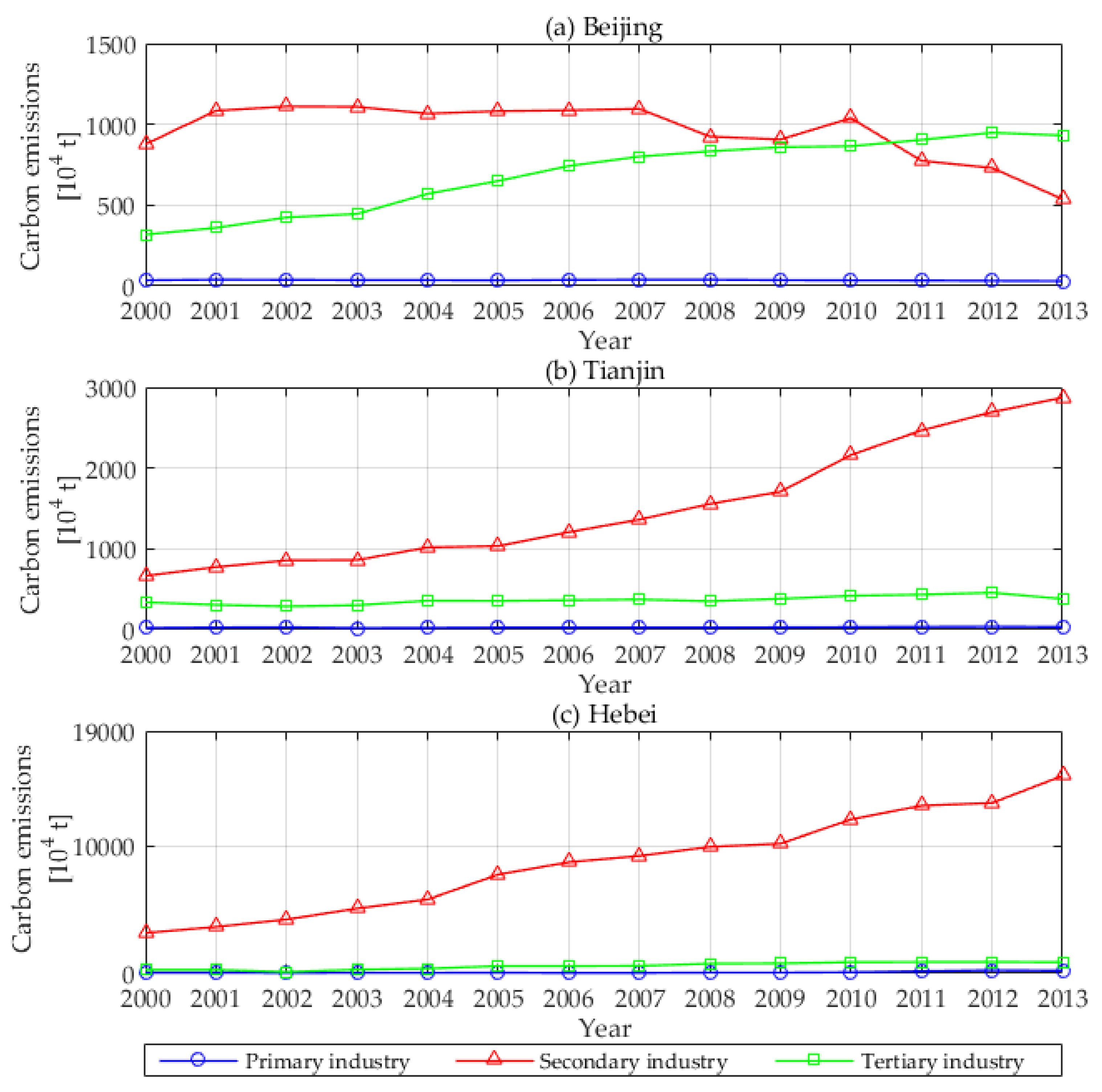
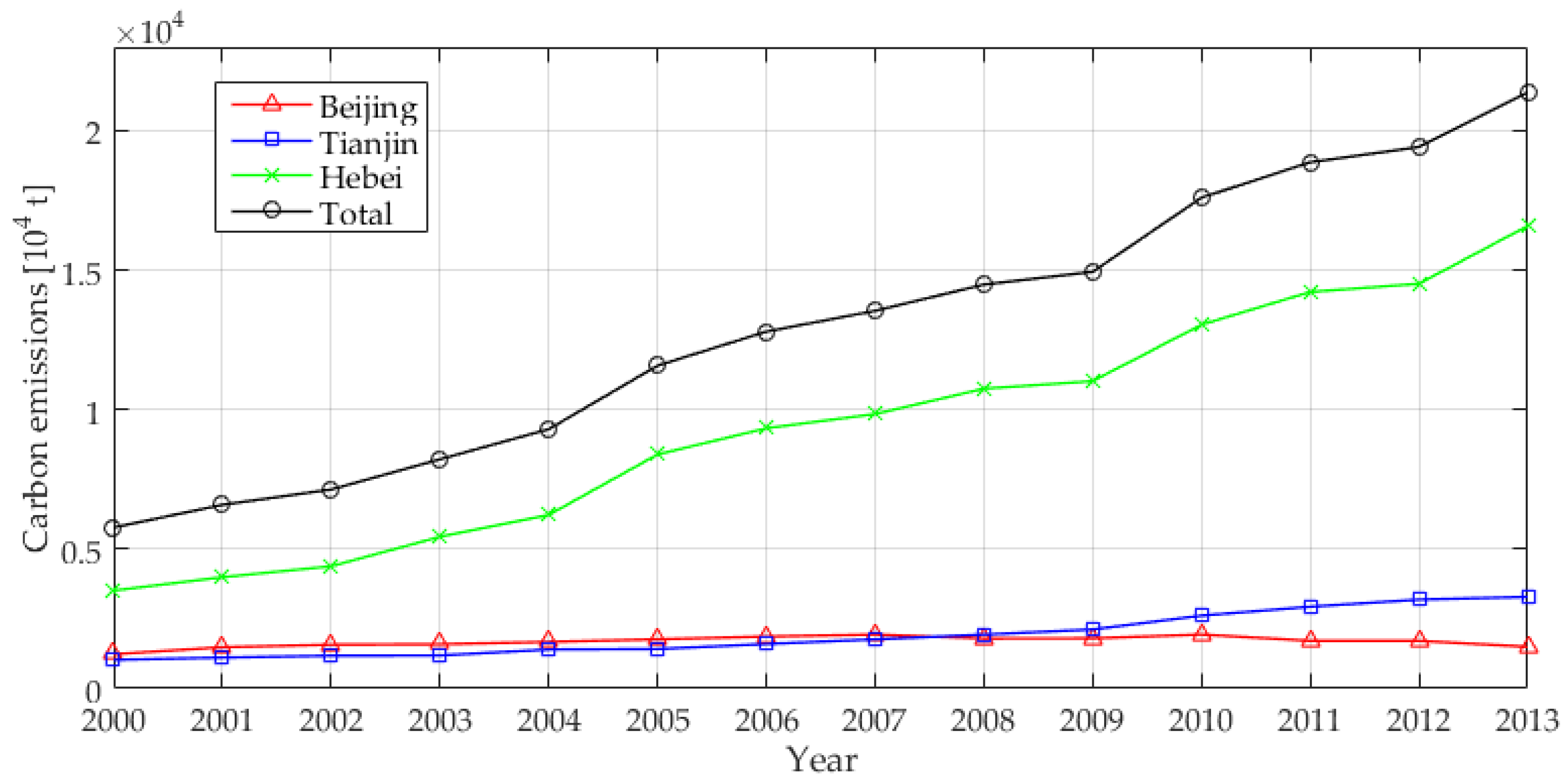

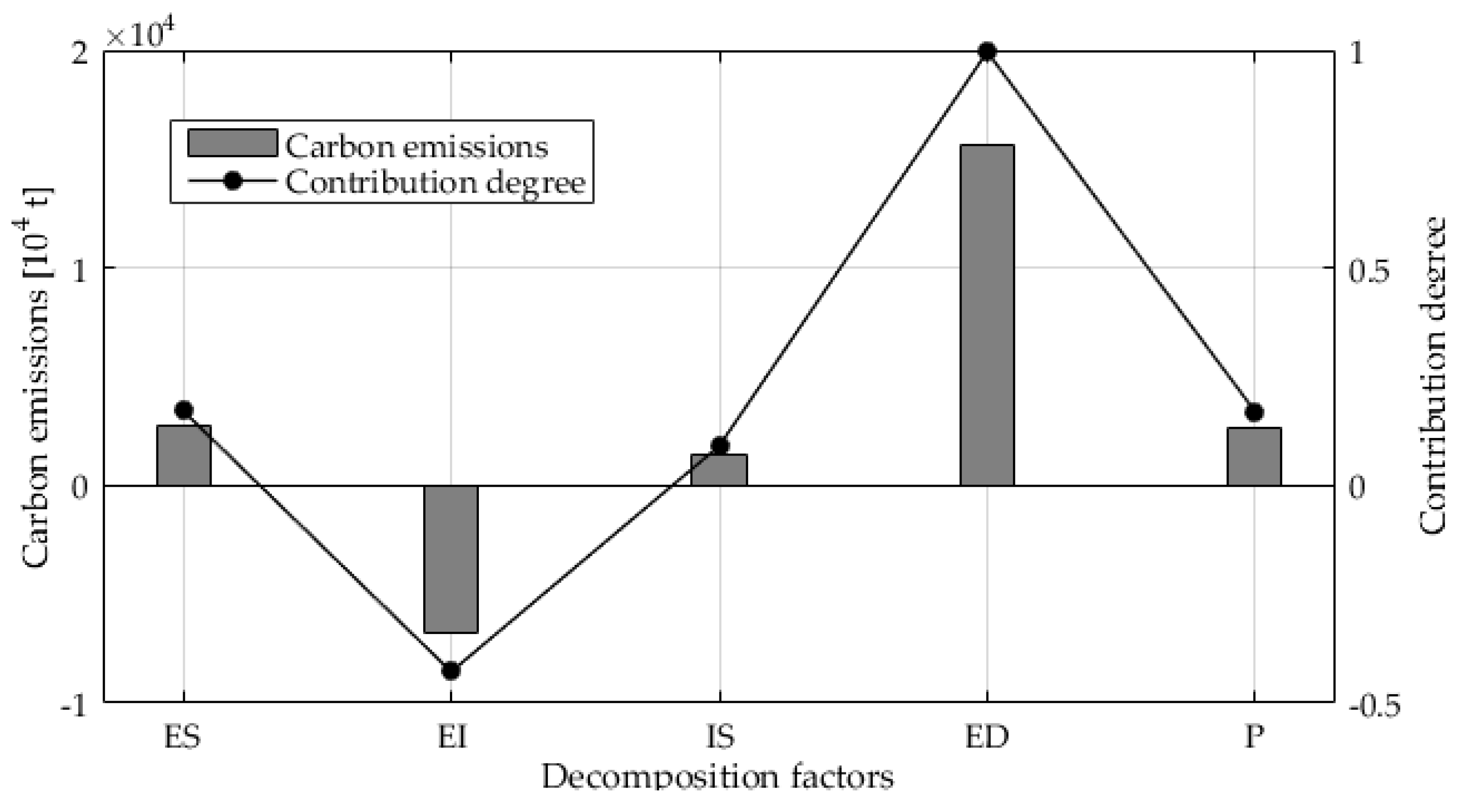
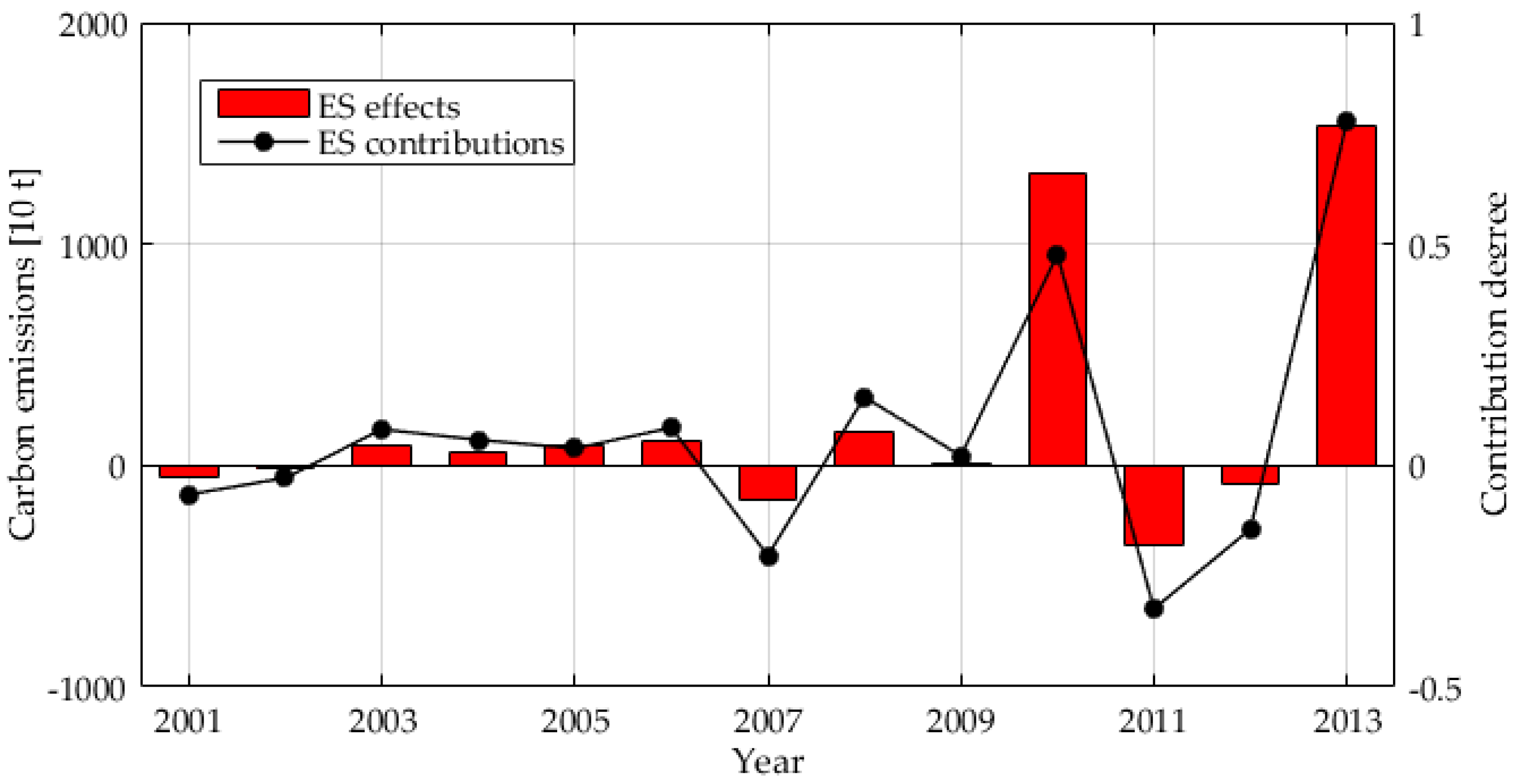
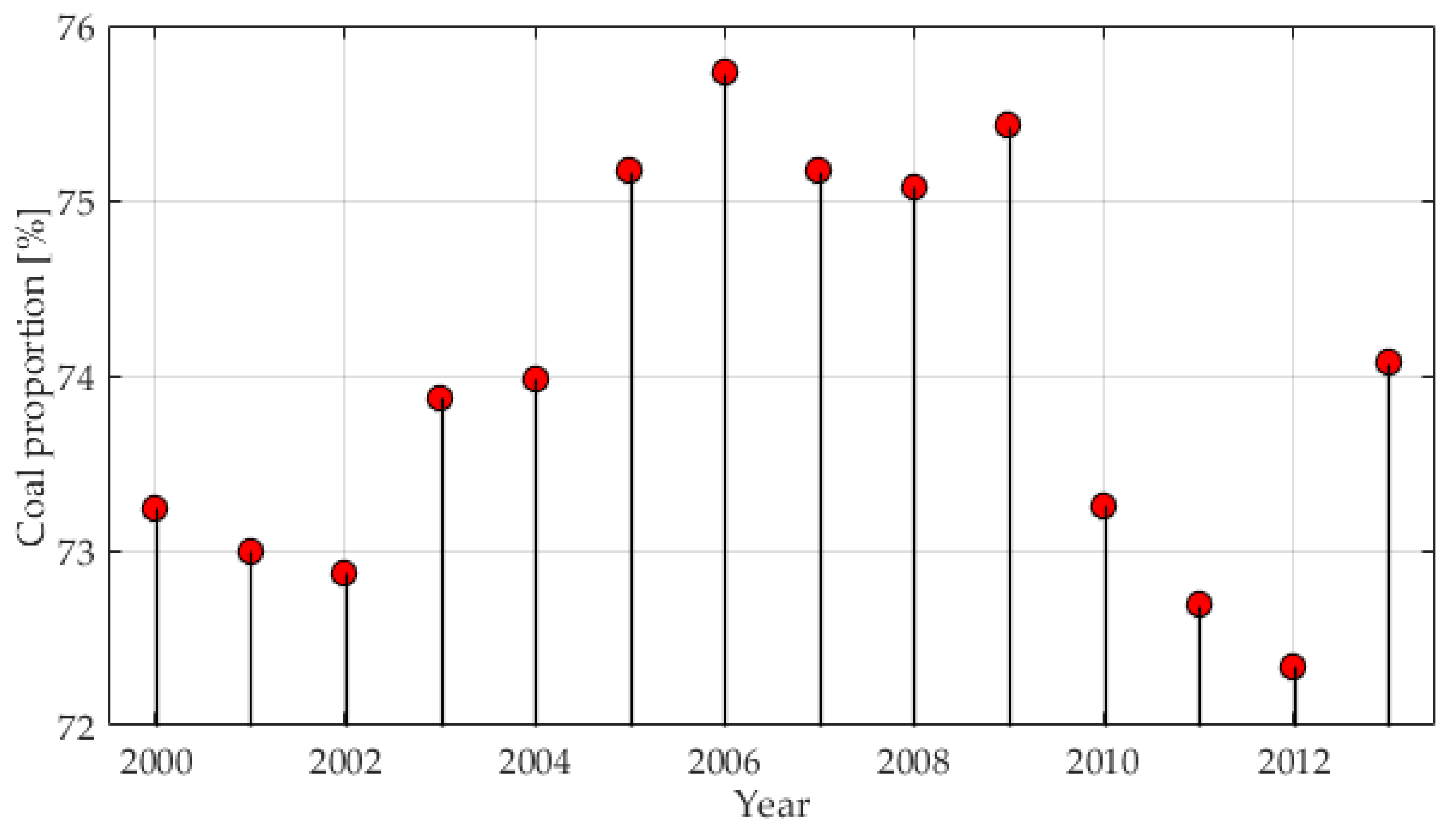

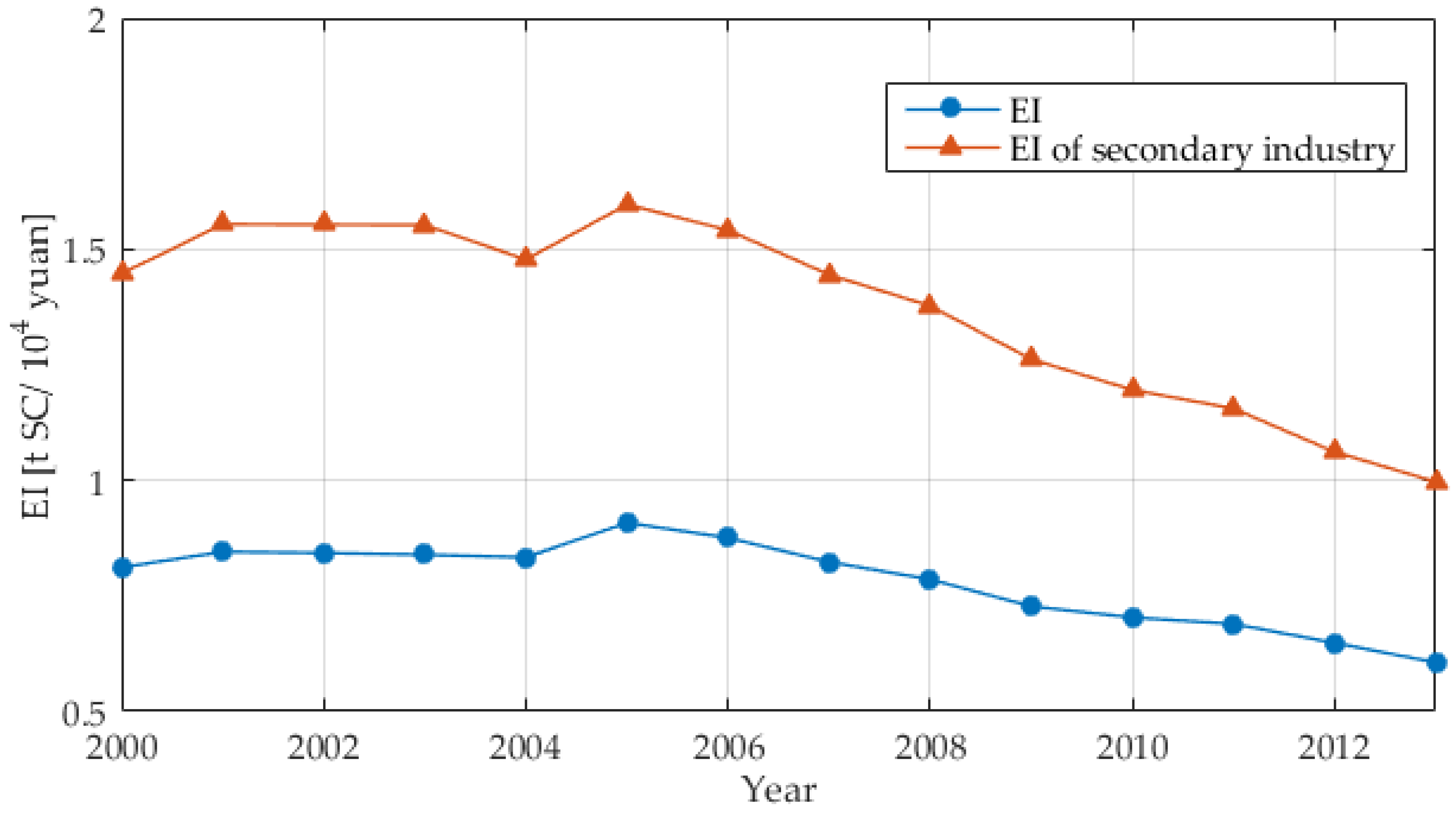
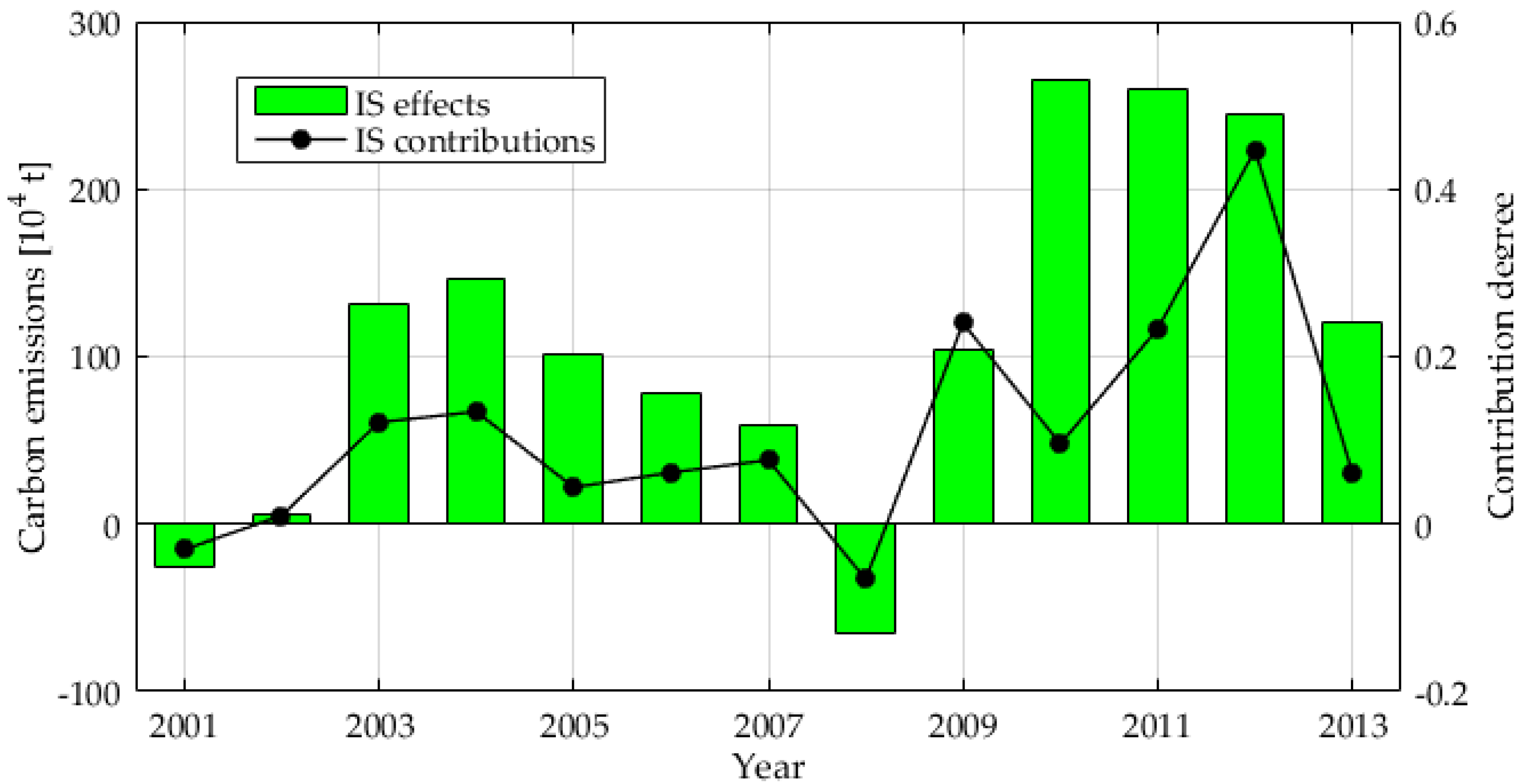

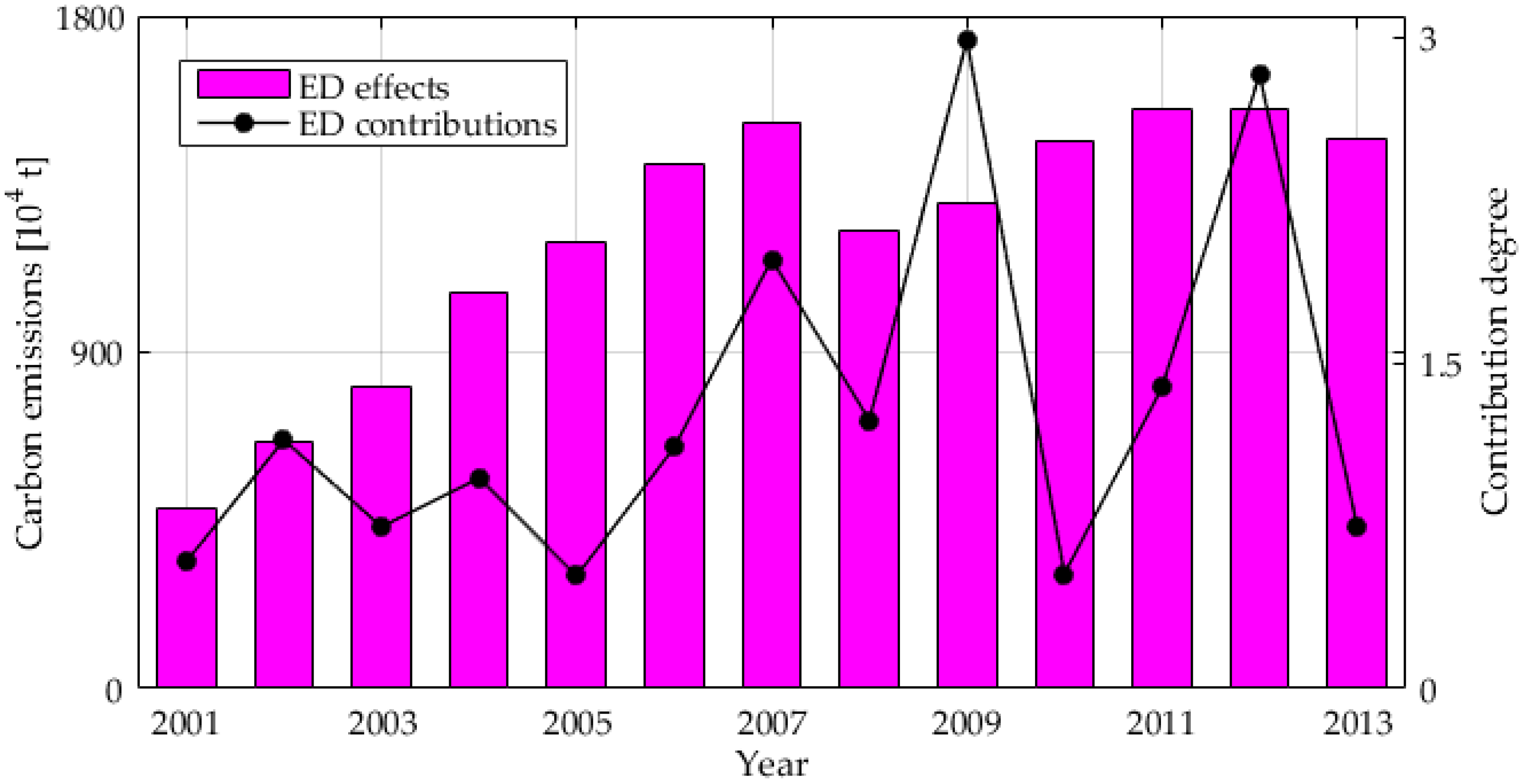
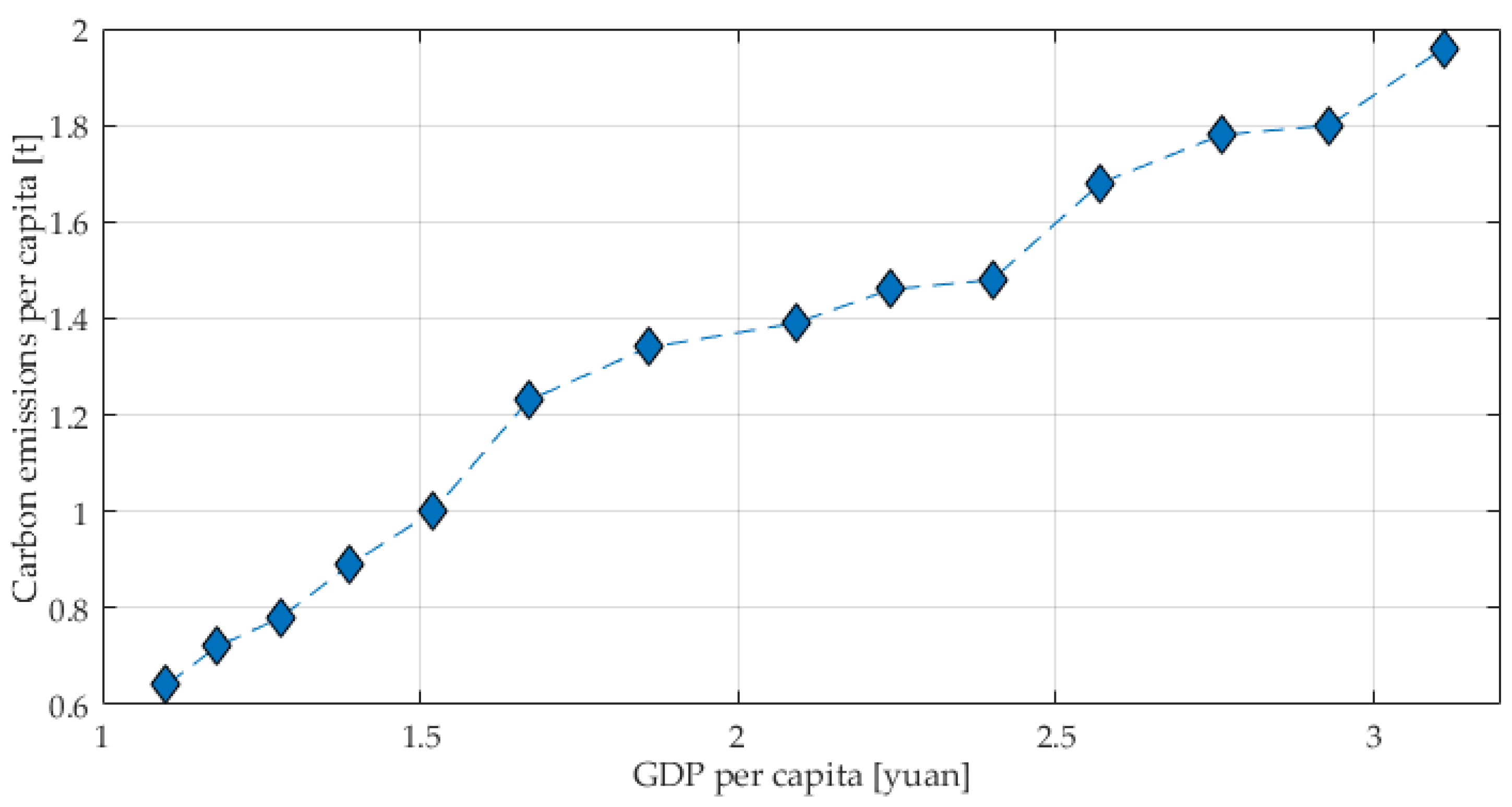
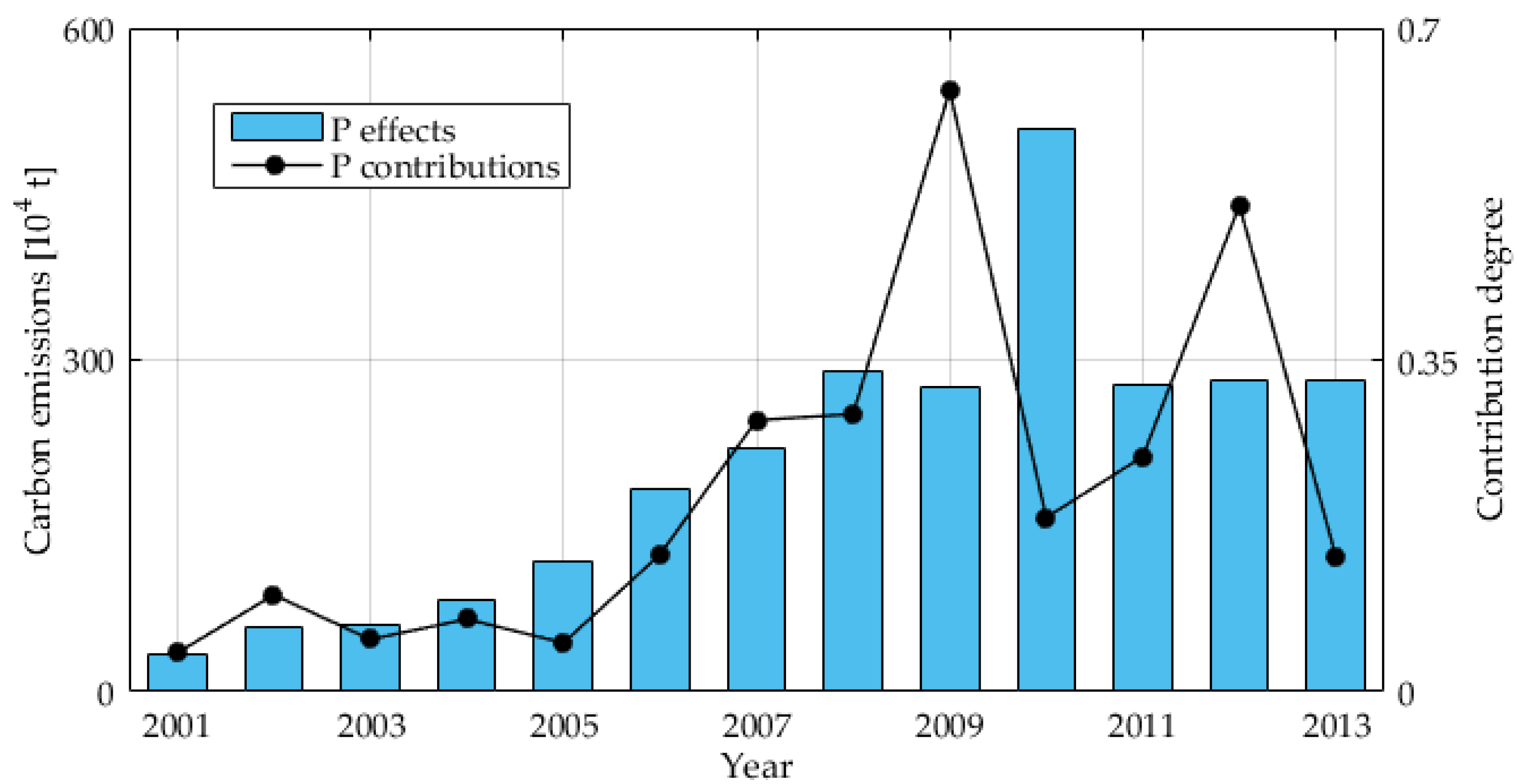
| Case | ut | ut−1 | u | |||
| 1 | 0 | + | 0 | + | ES | |
| 2 | + | 0 | + | 0 | ES | |
| 3 | 0 | + | + | + | 0 | EI, IS, ED, P |
| 4 | + | 0 | + | + | 0 | EI, IS, ED, P |
| Year | ES | EI | IS | ED | P | Total Effects |
|---|---|---|---|---|---|---|
| 2001 | −52.85 | 292.65 | −24.95 | 479.48 | 33.56 | 727.89 |
| 2002 | −20.06 | −141.23 | 6.09 | 658.87 | 58.70 | 562.37 |
| 2003 | 110.61 | 1.03 | 131.09 | 811.41 | 59.98 | 1114.11 |
| 2004 | 65.39 | −261.29 | 146.45 | 1057.43 | 83.37 | 1091.34 |
| 2005 | 91.74 | 794.87 | 100.58 | 1186.04 | 117.80 | 2291.05 |
| 2006 | 107.75 | −504.99 | 77.23 | 1394.60 | 181.65 | 1256.24 |
| 2007 | −154.36 | −865.06 | 58.13 | 1505.37 | 217.89 | 761.97 |
| 2008 | 152.24 | −606.23 | −64.78 | 1213.40 | 287.25 | 981.88 |
| 2009 | 9.46 | −1241.91 | 103.25 | 1286.97 | 272.98 | 430.75 |
| 2010 | 1365.38 | −748.29 | 249.36 | 1396.48 | 484.93 | 2747.86 |
| 2011 | −357.03 | −603.24 | 258.19 | 1536.09 | 274.60 | 1108.61 |
| 2012 | −77.47 | −1442.41 | 243.54 | 1542.20 | 279.46 | 545.33 |
| 2013 | 1508.96 | −1420.86 | 118.71 | 1458.98 | 278.23 | 1944.01 |
| Year | ES | EI | IS | ED | P | Total Effects |
|---|---|---|---|---|---|---|
| 2001 | −55.48 | 484.26 | −25.27 | 486.50 | 34.07 | 924.09 |
| 2002 | −12.31 | −122.28 | 5.38 | 656.16 | 58.50 | 585.46 |
| 2003 | 66.68 | −10.59 | 132.92 | 809.73 | 59.92 | 1058.66 |
| 2004 | 61.46 | −262.02 | 147.41 | 1066.75 | 84.20 | 1097.80 |
| 2005 | 84.90 | 803.70 | 101.52 | 1198.24 | 119.24 | 2307.60 |
| 2006 | 107.33 | −511.78 | 78.01 | 1410.56 | 183.88 | 1268.00 |
| 2007 | −157.89 | −877.98 | 58.96 | 1526.56 | 221.06 | 770.70 |
| 2008 | 153.04 | −616.14 | −65.90 | 1232.42 | 291.87 | 995.28 |
| 2009 | 9.41 | −1261.93 | 104.90 | 1307.15 | 277.30 | 436.83 |
| 2010 | 1276.00 | −830.92 | 282.11 | 1538.59 | 534.74 | 2800.51 |
| 2011 | −365.85 | −613.43 | 262.40 | 1562.23 | 279.37 | 1124.72 |
| 2012 | −79.94 | −1459.50 | 246.20 | 1561.24 | 282.96 | 550.96 |
| 2013 | 1562.94 | −1450.53 | 121.52 | 1489.27 | 284.14 | 2007.34 |
| Year | ES | EI | IS | ED | P | Total Effects |
|---|---|---|---|---|---|---|
| 2001 | −54.16 | 388.46 | −25.11 | 482.99 | 33.81 | 825.99 |
| 2002 | −16.19 | −131.75 | 5.74 | 657.52 | 58.60 | 573.91 |
| 2003 | 88.64 | −4.78 | 132.00 | 810.57 | 59.95 | 1086.38 |
| 2004 | 63.43 | −261.66 | 146.93 | 1062.09 | 83.78 | 1094.57 |
| 2005 | 88.32 | 799.29 | 101.05 | 1192.14 | 118.52 | 2299.32 |
| 2006 | 107.54 | −508.39 | 77.62 | 1402.58 | 182.77 | 1262.12 |
| 2007 | −156.12 | −871.52 | 58.54 | 1515.97 | 219.47 | 766.34 |
| 2008 | 152.64 | −611.19 | −65.34 | 1222.91 | 289.56 | 988.58 |
| 2009 | 9.44 | −1251.92 | 104.07 | 1297.06 | 275.14 | 433.79 |
| 2010 | 1320.69 | −789.61 | 265.73 | 1467.54 | 509.84 | 2774.19 |
| 2011 | −361.44 | −608.34 | 260.29 | 1549.16 | 276.99 | 1116.67 |
| 2012 | −78.71 | −1450.95 | 244.87 | 1551.72 | 281.21 | 548.14 |
| 2013 | 1535.95 | −1435.70 | 120.12 | 1474.12 | 281.18 | 1975.68 |
| Cumulative effects | 2700.04 | −6738.06 | 1426.52 | 15,686.37 | 2670.82 | 15,745.69 |
© 2018 by the authors. Licensee MDPI, Basel, Switzerland. This article is an open access article distributed under the terms and conditions of the Creative Commons Attribution (CC BY) license (http://creativecommons.org/licenses/by/4.0/).
Share and Cite
Liang, Y.; Niu, D.; Zhou, W.; Fan, Y. Decomposition Analysis of Carbon Emissions from Energy Consumption in Beijing-Tianjin-Hebei, China: A Weighted-Combination Model Based on Logarithmic Mean Divisia Index and Shapley Value. Sustainability 2018, 10, 2535. https://doi.org/10.3390/su10072535
Liang Y, Niu D, Zhou W, Fan Y. Decomposition Analysis of Carbon Emissions from Energy Consumption in Beijing-Tianjin-Hebei, China: A Weighted-Combination Model Based on Logarithmic Mean Divisia Index and Shapley Value. Sustainability. 2018; 10(7):2535. https://doi.org/10.3390/su10072535
Chicago/Turabian StyleLiang, Yi, Dongxiao Niu, Weiwei Zhou, and Yingying Fan. 2018. "Decomposition Analysis of Carbon Emissions from Energy Consumption in Beijing-Tianjin-Hebei, China: A Weighted-Combination Model Based on Logarithmic Mean Divisia Index and Shapley Value" Sustainability 10, no. 7: 2535. https://doi.org/10.3390/su10072535






